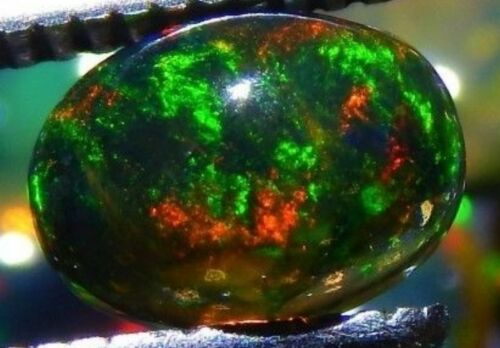-40%
18.84 ct Natural Black Ethiopian Opal Pear Cabochon (Video)
$ 633.07
- Description
- Size Guide
Description
Gem Type: Natural OpalWeight: 18.84 CT
Pattern: Flashfire
Face: Mid-Dome
Shape: Pear Cabochon
Opal Size: 29.1 x 15.3 x 10.6 mm
Transparency: Translucent
Origin: Welo / Wollo (Ethiopia)
Play-of-Colour: Full Multi-Colour (Red, Yellow, Orange, Green, Blue)
Brightness: 4 (1 - 5) (Dull, Subdued, Average, Bright, Brilliant)
Body Tone: N4
N1-N4 (Black Opal) N5-N6 (Dark Opal) N7-N9 (Light Opal)
Notes ? This is a natural Black Ethiopian Opal (not color treated). A picture is worth a thousand words and a video done correctly is worth a thousand pictures ? so please watch the Youtube video at the following link: https://www.youtube.com/watch?v=g2YPV2ztcnQ&t=5s
18 84ct
Video will open in a new window
Using the mobile app? Copy this link into your browser:
Offering one of the best selections of Opal on Ebay - please Visit our Store or take a look at our Other Listings. Free Shipping in the United States ... All International Sales will be shipped via eBay's Global Shipping Program. Every effort is made to ship within 2 business days. See page bottom for info about buying opals online.
QUESTIONS TO ASK BEFORE BUYING AN OPAL ONLINE:
Is there a video of the stone? A video will allow you to see a "thousand" pictures of the stone from various angles. It is the best chance of your being certain that you will get what you believe you are paying
for.
Is there more than one picture of the stone? A stone can be one-directional - such that it is only attractive from one viewing angle. If there is only one picture of the stone then there isn't much to go by.
Is it important to me what the back of the stone looks like? This is not critical but it does affect the value of the stone. If the sides of the stone have strong blemishes then it would be preferable to bezel set rather than prong set.
Am I aware of just how large a stone of a particular carat weight is? Some stones may only be appropriate in a ladies ring (approx. 3 carats or less with a high dome) while others may be suitable for a man's ring
or a pendant. Depending on the cut of the stone, some stones over 20 carats may only be suitable for use in a pendant.
If buying a black opal am I comfortable with the fact that the stone may have been treated? Opals that have been treated may show pock marks or blow-outs on the back of the gem. If the gem is an almost black Ethiopian opal then it has probably been treated.
Will the opal look anything like the picture(s) under normal lighting conditions? The play-of-color in an opal is best captured under subdued lighting conditions, hence many use rather dark conditions when filming an opal. Most Ethiopian opals will, in fact, look like white or light colored opals under normal lighting conditions. You should assume that the stone is a Light Opal unless the seller specifies a darker Body Tone or a stone appears to have a yellowish or brownish hue.
What type of faults does the stone have? Are there cracks or crazing in the stone? Is there a 'window' in the stone which is devoid of play-of-color? Is the stones body color consistent? Is there hazing or clouding in the stone? Does the stone have inclusions?
Opals are very much like people in that no two are exactly alike. It can be very difficult to find a 'perfect' gem ... but does the gem represent a good value for the price that is being asked?
Be familiar with the different types of opal; from Black Opal, Semi-Dark Opal, Crystal Opal, Light Opal, Boulder Opal, Jelly Opal, Matrix Opal, Fairy Opal, Doublets, Triplets, Dendrite Opal, and Common Opal or Potch.
Be familiar with where opal comes from; classic Australian Opal, Brazilian Opal (considered by some to be even more indestructible), Mexican Opal (often called Fire Opal from its orange hue), Ethiopian Hydrophane Type Opal, and even American Nevada Opal.
Understand the unique qualities of Ethiopian Opal. Almost all Ethiopian Opal is a Hydrophane type of opal. It is also called a 'living stone' because of its high water content and its ability to act as a sponge. It is more susceptible to damage from dehydration such that it should be kept in a ziplock back with a moistened cotton ball if stored in a bank vault for long periods. In the winter time even, a persons home can be more arid than a desert - so take precaution. Due to this ability to gain and lose water content it is actually quite common for an Ethiopian Opal to become more translucent or even transparent when worn in close proximity to the humid human body. Thus, it is more advisable with Ethiopian Opals to use a black enamel coating on the back of the gem or to use a metal backing in the setting. It should also be assumed that greater than 95% of all Ethiopian Opals have been treated or sealed with Opticon or a similar agent in order to ward off the absorbtion or body oils and lotions as well as to protect against rapid shrinking and expansion. Finally, due to its naturally 'thirsty' nature, it should be assumed that all black Ethiopian Opals have been color-treated unless otherwise stated by a trustworthy seller. If you place an Ethiopian Opal against your tongue or in your mouth and it doesn't feel 'sticky', then you know that it has been sealed with Opticon or some other agent - which is actually preferable with an Ethiopian Opal.
Best Wishes On Your Search for Treasure,
- Last Chance Shiny Things














